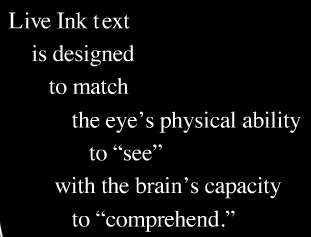Live Ink is an alternative approach to presenting texts in screen environments, arranging them in series of cascading phrases to increase readability (I saw this a couple of years ago at an educational publishing conference but it was brought to my attention again on Information Aesthetics). Live Ink was developed by brothers Stan and Randall Walker, both medical doctors (Stan an ophthalmologist), who over time became interested in the problems, especially among the young, of reading from computer displays. In their words:

Here’a screenshot of their sample reader with chapter 1 of Moby-Dick:

Thoughts?
if:book
A Project of the Institute for the Future of the Book

Interesting. When I’m studying a piece of prose seriously, I often type it into my computer so I can break the sentences apart by clauses into separate, indented lines. It’s amazing how much easier it is to see a sentence’s structure and rhythm when aided by white space.
I don’t know if I’d want everything I read formatted like that – the line breaks disrupt my train of thought. But as more text gets published in mediums that don’t require that it be condensed to fit in a physical space, we might see a lot more of it.
Mechanical line composition for newspapers was based on a column width using about 1/3 the number of characters found in a browser rendered (10 pt.) line at if:book. Did they know something about legibility and immediacy of meaning? Did they understand an ergonomic of comprehension? Why did they also use an indent rather than a blank line return to prompt paragraphs?
I was impressed when I first saw it, despite my initial skepticism, and I’m impressed again. I used to speed-read as a kid. My reading skills, perseverance and speed have all since steadily degraded. Maybe this will get me reading voraciously again.
No, I don’t like those line breaks. They change the text – they make a different book, not what the author wrote. Gives too much emphasis to the arbitrarily chosen last words on a line, and slides the work into a paradigm of “Poetry” that is very distorting.